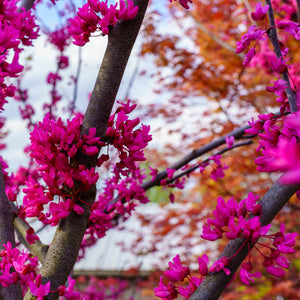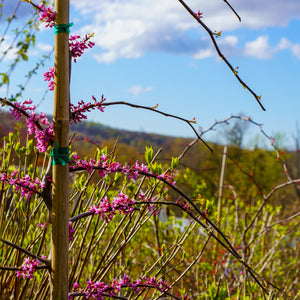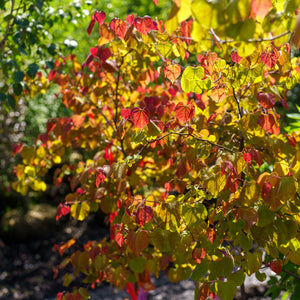The Redbud Guide
Redbud trees (Cercis spp.) are prized for their early spring flowers, striking foliage, and compact size, making them a favorite ornamental tree in residential and commercial landscapes. These deciduous trees are native to North America and Asia and are known for their signature heart-shaped leaves, smooth bark, and clusters of small, pea-like flowers that bloom profusely along bare branches before foliage emerges.
About
The genus Cercis includes several species, but the most commonly cultivated are Eastern redbud (Cercis canadensis), Chinese redbud (Cercis chinensis), and a growing number of hybrids and cultivars that offer unique forms, foliage colors, and compact growth habits.
Cercis canadensis is native to eastern North America and typically grows 20–30 feet tall with a similar spread. Its adaptable nature, beautiful spring bloom, and tolerance of urban conditions have made it one of the most widely used flowering trees in American gardens. Varieties like 'Forest Pansy' (with deep burgundy foliage), 'Hearts of Gold' (chartreuse leaves), and 'Ruby Falls' (weeping form) have added new layers of ornamental interest.
Cercis chinensis, the Chinese redbud, is more compact and shrub-like, typically growing 10–15 feet tall. It offers showier blooms and denser branching than its North American counterpart. Selections like 'Avondale' and 'Don Egolf' are known for their prolific flowering and suitability for smaller spaces.
Redbuds are among the first trees to bloom in spring, often starting in March or April depending on the climate. Their flowers emerge directly from old wood—a trait called cauliflory—creating a dramatic effect on bare trunks and branches. Summer foliage is equally appealing, with many cultivars offering vibrant purple, gold, or variegated leaves. In autumn, leaves typically turn shades of yellow.
These trees thrive in full sun to partial shade, tolerate a variety of soil types, and are remarkably low-maintenance once established. Redbuds support local pollinators and can be used in a wide range of garden settings, from urban courtyards to woodland edges.
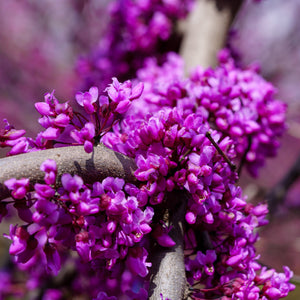
PLANTING
USDA Hardiness Zones: Most redbuds grow well in Zones 4–9. Some cultivars, especially those of Chinese origin, prefer Zones 6–9.
Soil: Moist, well-drained soils are best. Redbuds can tolerate clay but may struggle in poorly drained or alkaline soils.
Sunlight: Full sun to part shade. At least 4–6 hours of sun is recommended for best flowering and foliage color.
Watering: Keep the soil evenly moist during establishment. Mature trees are somewhat drought-tolerant but benefit from watering during dry periods.
Spacing: Allow at least 15–30 feet depending on cultivar. Weeping and dwarf forms need less space.
Planting Time: Plant in early spring or fall when temperatures are cool and rainfall is more reliable.
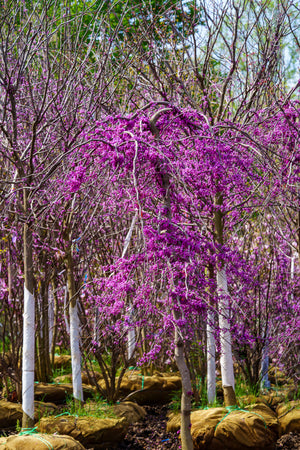
CARE
Watering: Deep water young trees weekly during the first two years. Older trees require supplemental water only during extended dry periods.
Fertilizing: Apply a slow-release balanced fertilizer in early spring. Avoid over-fertilization as it can lead to excessive leaf growth at the expense of flowers.
Pruning: Prune after flowering to shape the canopy and remove any dead, diseased, or crossing branches. Avoid heavy pruning as redbuds bloom on old wood.
Pests and Diseases: Generally low-maintenance, though canker and verticillium wilt may appear in stressed trees. Aphids and caterpillars are occasional nuisances.
Mulching: Apply mulch around the base to retain moisture and protect roots, keeping mulch a few inches away from the trunk.
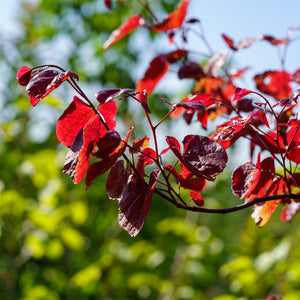
HOW TO USE
Focal Point: Redbuds shine as focal point trees due to their dramatic spring bloom and colorful foliage. Use cultivars like 'Flame Thrower' or 'Ruby Falls' as specimen trees in lawns or near entrances.
Small Garden Trees: Compact varieties like 'Ace of Hearts' and 'Avondale' are perfect for tight spaces, patios, or containers. Their controlled growth and elegant form make them ideal for urban gardens.
Woodland Edges: Naturalistic plantings benefit from redbuds’ native character. Plant them under taller canopy trees or along the edge of woods with companions like dogwoods, serviceberries, and ferns.
Pollinator Gardens: Their early blooms provide nectar for bees and butterflies. Pair redbuds with native perennials such as Echinacea, Monarda, and Aquilegia.
Mixed Borders: Add structure and seasonal interest by combining redbuds with flowering shrubs like Hydrangea, Viburnum, and Fothergilla.
Slope and Hillside Plantings: Their strong roots help stabilize soil and add seasonal beauty to otherwise unused spaces.
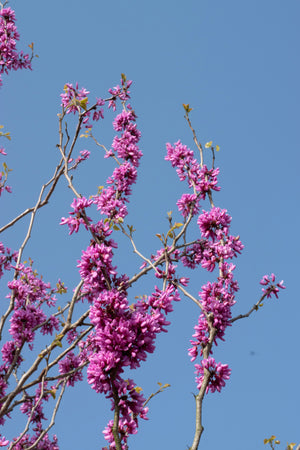
Common Questions
How big do redbud trees get? Depending on the variety, redbuds can range from 10 to 30 feet tall and wide. Dwarf and weeping selections remain smaller.
How fast do Eastern redbud trees grow? Eastern redbuds are moderately fast growers, typically adding 1–2 feet per year under ideal conditions.
How to plant a redbud tree? Choose a sunny to partly shaded site with well-drained soil. Dig a hole twice as wide as the root ball, set the tree at the same depth it grew in the container, backfill, water thoroughly, and mulch.
How to prune a redbud tree? Prune in late spring after flowering. Remove crossing or inward-growing branches to open the canopy and maintain shape.
Do deer eat redbud trees? Redbuds are somewhat deer resistant, though young trees may be browsed in winter.
How long do redbud trees live? Redbuds typically live 20–30 years, though proper care can extend their life.
What does a redbud tree look like? Redbuds have a graceful branching habit, heart-shaped leaves, and vibrant clusters of pink, purple, or white spring flowers.
When do redbuds bloom? Redbuds usually bloom in early spring before the leaves emerge—typically March through April.
Do redbuds need full sun? Redbuds perform best in full sun to part shade. Too much shade may reduce flower production.
Conclusion
Redbud trees are one of the most versatile and rewarding small trees for modern landscapes. With their bold seasonal color, unique branch structure, and manageable size, redbuds offer year-round appeal. Whether you're designing a pollinator-friendly yard or highlighting a key garden space with a focal point tree, redbuds are a timeless and practical choice.
The Redbud Collection
Sold Out
Sold Out

